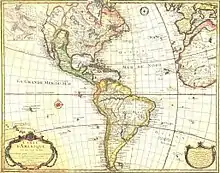Santa María (ship)
La Santa María (The Saint Mary), alternatively La Gallega, was the largest of the three ships used by Christopher Columbus in his first voyage across the Atlantic Ocean in 1492, the others being the Niña and the Pinta. Her master and owner was Juan de la Cosa, a man from Santoña, Cantabria, operating in south Spanish waters. Requisitioned by order of Queen Isabella and by contract with Christopher Columbus, whom de la Cosa knew previously, the Santa Maria became Columbus' flagship on the voyage as long as it was afloat. Having gone aground on Christmas Day, 1492, on the shores of Haiti, through inexperience of the helmsman, it was partially dismantled to obtain timbers for Fort Navidad, "Christmas Fort," placed in a native Taíno village. The fort was the first Spanish settlement in the New World, which Columbus had claimed for Spain. He thus regarded the wreck as providential. The hull remained where it was, the subject of much modern wreck-hunting without successful conclusion.
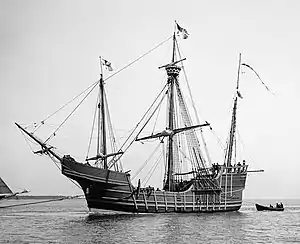 1892 replica | |
| History | |
|---|---|
| Name: | La Santa Maria, "The Saint Mary," also La Gallega, on and before the beginning of Columbus' first voyage on 3 August 1492. |
| Owner: | Juan de la Cosa |
| Launched: | Unknown and speculative |
| Stricken: | 25 December 1492 |
| Fate: | Ranaground on a shoal near Hispaniola |
| Status: | Partly dismantled; the timber being used to build an ill-fated fort on Hispaniola. |
| General characteristics | |
| Type: | Nao, at that period distinguished by Columbus from the smaller Caravel, and distinct from the Carrack. |
| Displacement: | est. 150 metric tons of displacement |
| Tons burthen: | est. 108 tons BM |
| Length: |
|
| Beam: | est. 5.5 m (18 ft) |
| Draught: | est. 3.2 m (10 ft) |
| Propulsion: | sail |
| Complement: | 40 |
| Armament: | 4 × 90 mm bombards, 50 mm culebrinas |
| Notes: | The ship on the first voyage was captained by Juan de la Cosa. The navigation and command of the squadron was done by Christopher Columbus. |
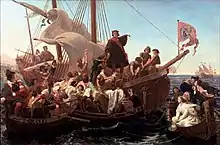
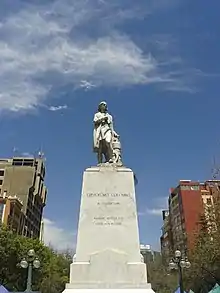
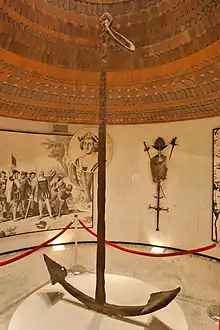
_-_IMG_0207.JPG.webp)
The name and provenience of the Santa Maria
There is less certainty about its name than for the other two ships. Columbus' Journal of Navigation[1] for the first voyage frequently refers to the Pinta and the Nina by name, and often asserts that they were caravels, but it never refers to the flagship by name.[2] The surviving journal may contain flaws. The original journal, sent to the monarchs of Spain, did not survive, but an abstract (full of errors) by the historian, Bartolomé de las Casas, did.[3]
The historians offer two names: Gonzalo Fernández de Oviedo y Valdés calls it Gallega; Antonio de Herrera y Tordesillas, Santa Maria.[2] One solution to the conundrum is that the ship began under de la Cosa as Gallega and was changed by Columbus to Santa Maria,[4] but there are other theories as well. Moreover, "la Gallega" can be taken as "the Galician," suggesting that the ship was constructed in that province and was named after it.[5] In the absence of proof, scholars can only speculate. C.E. Nowell remarked:
"There is a lunatic fringe of writers determined to establish far-fetched theories regarding the Columbus enterprise or to prove that the discoverer was of some nationality hitherto unsuspected."[6]
Master of the Santa Maria
Columbus encountered Juan de la Cosa apparently by accident in the port of Palos de la Frontera[7] (circumstances moved so quickly with such unexpected result as to preclude any pre-arrangement between Columbus and de la Cosa; see below), the point of embarkation for the yet undiscovered New World. De la Cosa was a professional master, navigator, and entrepreneur. His assistance would turn out to be a sine qua non-of the voyages of Columbus, and yet, due to the self-aggrandizement of Columbus in his journal,[8] and its revision and continuation by his son, de la Cosa remains a shadowy figure, except for the contribution for which he is best known, the earliest known surviving map of the New World.
The problem of the identity of Juan de la Cosa
In early May 1492, Columbus, a newly appointed admiral in the royal navy,[9] and entourage show up at the port of Palos under orders from the queen to conduct an expedition westward looking for a route to the Indies. He carries with him also orders to the port authorities to impress a squadron of three caravels with supplies and crews, who thereafter would serve in the navy at regular seaman's pay. Two of the caravels were to be selected by the port authorities. They impressed the Nina and the Pinta, quite small caravels with a single deck each. The third was left up to Columbus to select.
The mission and the orders were unpopular.[10] The resistance of the town in every quarter extended the time required to obtain compliance. Given 10 days by the orders, they took 10 weeks. According to De la Riega, the general consensus of the late 19th century (still considered true today) was that "there was no time or money to go from port to port examining ships ...."[11] Columbus necessarily chose a ship available in port, the nao Santa Maria/Gallega, with, presumably, the additional advantage of Juan de la Cosa as captain, a famous navigator and geographer. There was then only one nao to which the names applied (in whatever sequence), and not two.
Mutiny on the Santa Maria
The relationship between Columbus and de la Cosa (hereinafter referenced as "the admiral" and "the captain", as they are in the journal) was problematic. The same problem was true of the other two ships; even though all had agreed to sail voluntarily (but unwillingly and with bad grace), the complaints and the non-cooperation, now called mutiny, continued. Aboard the Santa Maria, as both the admiral and the captain were in the service of the Crown, the admiral had the rank. The ship-handling, however, was supposed to be the province of the captain. This protocol had been established in the very first Roman fleet, and, like the protocols of the Roman army, had prevailed in all the fleets of the countries descending from the Roman Empire. In any fleet, or its diminutive flotilla, or squadron, the commander of all the ships reported to the central government and held the position of admiral, regardless of any other social or military rank he may have had. The commander of any one ship was its magister, or "master;" that is, the captain, or "head." He ran the ship, only providing an office for the admiral, and receiving from him the same orders as the other captains. This relationship must prevail until the ship was officially detached from the flotilla.
The journal reveals that in the first voyage these relationships were never settled. Columbus often overstepped his province and the masters with their men often disobeyed. For example, on the homeward leg, when Columbus is commanding the remaining two ships from the Nina, he is so uncomfortable that he wishes to rush home to bring matters before the queen, reported in this quote from Columbus:
I will not suffer the deeds of evil-disposed persons, with little worth, who, without respect for him to whom they owe their positions, presume to set up their own wills with little ceremony.[12]
When the ship was finally lost off Haiti, the captain refused to follow the admiral's plan for extracting the ship from the sandbank and instead sought help from the Nina. The admiral accused him of treason and desertion in the face of danger,[13] serious charges, for which defendants have received the death penalty. Judging by the vituperation in the journal, one might expect to read of some sort of court martial or attempted court martial at home afterward.
There is no record of any such proceedings. Moreover, the Life of Columbus by his son, who surely possessed Columbus' journal. is strangely lacking in references to Juan de la Cosa by name. Even in the shipwrecking incident, the son reports only that
Very soon the ship's master, whose watch it was, ran up ...
Here the admiral is being portrayed as the captain of the ship, while "the master" evidently is reduced in rank to an ordinary seaman. Real captains, unless in a vessel much smaller than the nao, do not stand watch (the men on active duty), which reports to the captain (or should report). If Columbus is commanding the ship, apparently his master has nothing to do.[14] He is not even worthy of a name. This is where the irreconcilable contradictions in the evidence begin. Columbus obliterates Juan de la Cosa from his records.
The heroic disgrace
The proof of his existence and his status is given in a conciliatory letter from the crown to the man over a year later, on 28 February 1494, which is phrased in the form of a judgement at the end of an unrecorded process:
D. Fernando and Doña Isabel ... Salutations and thanks to you Juan de la Cosa, resident (vesino) of Santa Maria del Puerto, you have given us good service and we hope that you will help us from now on. In our service at our mandate you sailed as captain of a nao of yours to the ocean seas (por maestre de una nao vuestra á los mares del Océano). On that trip during which the lands and islands of the Indies were discovered, you lost your nao. In payment and satisfaction (por vos lo remunerar é satisfacer) we hereby give you license and faculty to take from the city of Jerez de la Frontera, or from any other city or town or province of Andalusia, two hundred cahises of wheat[15] to be loaded and carried from Andalusia to our province of Guipúzcoa, and to our county and the lordship of Vizcaya, and not elsewhere ... Given in the town of Medina del Campo on the 28th day of the month of February, year of the birth of Our Lord Jesus Christ of one thousand four hundred and ninety and four years.[16]
The journal portrays a mutinous shipmaster who had refused duty, had disobeyed orders, and had lost the ship. Now the admiral was on the way to seek military justice from the sovereign. However, the first account of the sovereign's response gives no hint of any such violations. Pery says:
... the Royal Decree of February 28, 1494, does not seem made for anyone disgraced ... (it) has no turning point: a man who disgraces himself by losing a ship ... cannot be paid for the ship ... the aforementioned letter makes us think that ... the story of events is one of many added by Father Las Casas ...[17]
Too many places at once
There are a number of other logical difficulties with this now isolated legal document; that is, its participants no doubt knew what they meant by its terms, but not enough knowledge of the circumstances survives to clarify their meaning. For example, does "una nao vuestra" imply that Juan de la Cosa had more than one ship of which the crown impressed one? In either case de la Cosa is clearly an entrepreneur or he would not be interested in transporting grain to sell. But if he had only one ship, and that was lost, how was he to transport the grain? Worse, Columbus had already left for his second voyage. There is strong evidence that de la Cosa was a member of it and therefore was not even in Spain when the letter addressed to him was published by the court. These difficulties are sufficient to have resulted in the proposition that there were two Juan de la Cosa's, one a master and entrepreneur, and the other a cartographer (see below).
There is additional evidence as to the location of "Santa Maria del Puerto," of which de la Cosa is stated to have been its vesino.[18] Not stated is whether it was his native community, or he moved there from elsewhere, or whether his company was located there, or his ships constructed and harbored there. Fortuitously a contemporary letter of the queen gives evidence as to its location, today considered most probable. The letter addresses Juan Rodríguez de Fonseca, the Bishop of Badajoz and royal officer managing the fleet. It is dated 25 August 1496, one month after the return of the fleet. It informs the Bishop that Juan de la Cosa, a vesino of Puerto de Santonia, had petitioned the crown for payment of salary accrued to men who had died in the service of the queen, presumably to be distributed to the relatives.[19] If de la Cosa went on the second voyage, he must have been a vesino of Santa Maria del Puerto when the queen was considering his petition for compensation for his ship. As he did not move while at sea and he was a vesino of Santoña within a month of his return, Santa Maria del Puerto and Santoña must be the same place, more or less, justifying the hypothesis that Santa Maria del Puerto is a prior name of Santoña.[20]
The etymology of the name is believed to be as follows: an object, "Santa Maria," is being stated to be in a place called Puerto. Fortuitously a single reference from a classical author provides a likely identification of Puerto.
Juan Vizcaino comes to light
An ancestral home in Santoña and vicinity is supported by other evidence. There is a church in the vicinity, Santa Maria del Puerto, which once must have had a parish. No parish records concerning Juan have been identified, but the deficit can be explained by known fires over the centuries. There is a district named after the de la Cosa family, who were noble patrons of the neighborhood,[21] and there was also a reputed family home. The de la Cosas were prosperous mariners, explaining how Juan might have gotten the Santa Maria (but different theories have been proposed). In any case the high proportion of Cantabrians in the crew supports the theory.[22]
The name, de la Cosa, is consistent with the conventions of forming Spanish names from Basque names. The "de" was prefixed to the name as a sign of their legal nobility. It did not refer to a patronym, as in Indo-European, or to a place.[23] The remaining part of the name was a Basque name, formed according to the conventions of the Basque language. Juan's Basque name is cited in other publications of the times as Lacoza, Lakotsa, Lakotya, La Cosa, and Lakoza. An alternative is Juan Vizcaíno, "John the Basque."[24]
Was the historical Juan de la Cosa one man or two?
The evidence concerning Juan de la Cosa is divided in two, an early, poorly attested period up to the missing turning point mentioned by Pery (above), in which he is a shipmaster and entrepreneur, and a later, well attested explorer serving in many senior roles: navigator, cartographer, master and consultant, who continued to sail with Columbus and also with other explorers such as Amerigo Vespucci. His is the earliest known surviving map of the new world. This bold explorer was killed by a poisoned arrow in a Custer-like raid on the natives, whom the Spanish had, evidently, underestimated. The early history of the Santa Maria belongs to the early phase.
The map
.jpg.webp)
The most certain evidence of Juan de la Cosa, cartographer, is a world map on parchment discovered in 1832, now in the Museo Naval in Madrid.[25] The map bears the inscription:
- Juan de la cosa la fizo en el puerto de S: ma en año de 1500
which can be translated
- Juan de la Cosa made it in the port of Santa Maria in the year 1500
"Puerto de Santa Maria" is not the same place as "Santa Maria del Puerto." In the former case, the Puerto is named Santa Maria. In the latter case the community of Santa Maria is located within the terrain called Puerto. The minority view regards them as variants, perhaps by error, of the name of the same place, but the majority view regards the former as a port near Cádiz in Andalusia famous for its role in New World exploration. Regardless of whether Santa Maria is one place or two, Santona can still figure as Juan's birthplace. In either case, how Juan arrived at Andalusia from Cantabria is a gap, one explanation being that there were two Juan's from Santona, but even that explanation requires a move.
The authenticity of the map has always been in question, especially since much of it is illegible to the unaided eye due to its dilapidated condition. Multispectral analysis, however, has brought out sufficient detail to perform cartographic and geographic analyses upon it, which are ongoing, and have been and are being published in a large variety of sources, many of them graphic. This article relies mainly on the summary given by Arthur Davies, who developed his theses in different articles and came to work up a standard summary.[26]
Exploration in the late 15th century was in the hands of a small class of veteran mariners, such as Columbus, de la Cosa, Vespucci, Cabot (another Genoese), and not a few others. History has dubbed these men and their companions Conquistadores from the later historical results, but it is unlikely that they viewed themselves as such in Columbus' time, being mainly interested in trade, gold, and colonization. Conquest is what they finally had to do to accomplish those goals in the lands of the natives. The resources for their explorations were provided by the monarchs of the major maritime countries: Ferdinand and Isabella of Spain, John II of Portugal and his successor, Manuel I of Portugal, and Henry VII of England. These monarchs in particular made exploration and possession of the New World their main preoccupation. They often allocated unlimited funding to the expeditions.
The professional mariners had to be first of all skilled ship captains. Second, they had to be able to navigate and be familiar with charts (a trade word for marine maps). Unlike today's navigators, who rely on admiralty charts and GPS's to determine position within a few feet, 15th century mariners made their own charts during exploration of unknown lands, the "Portolan charts," from which subsequent sailors to the region would take sailing directions. These were promulgated freely among the mariners, in contrast to the classical protocols of secrecy. The monarchs, who had formulated treaties among themselves, needed to know as quickly as possible who had discovered and claimed what land masses, and when.[27]
In Columbus' times, the ad hoc portolans were brought back to the office of the chief navigator (whether captain or some other officer) where they were transferred to a mappa mundi, "world map." This latter was on view to any professional who visited the office. The mariners all knew each other. When not voyaging they visited each other to donate their own data and read the latest data from the mappa kept there. The development of the latest maps was their common cause, otherwise they continued to compete.
That Juan de la Cosa had his own office at Puerto de Santa Maria is thus made certain by the surviving map, published in 1500 under his name. That he did not himself draw the mappa is shown by the names assigned places on coasts he visited, and had a major hand in the nomenclature, such as the coast of Venezuela in 1499, but appear garbled or incomprehensible on the map, which must be attributed to a draftsman. De la Cosa knew what names he had assigned.[28] That he supervised work on the mappa is shown by the fact that he wrote instructions on it concerning the data that was to appear there.
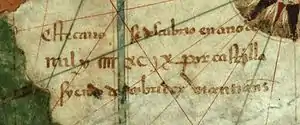
this cape was discovered in the year of 1499 by Castile being the discoverer Vicente Yáñez
The publication date of the mappa is substantiated by the data that appears upon it. Landforms east of the Amazon were discovered by Vicente Pinzon, 1499 – 1500. Their appearance on the mappa must be dated to after September 1500, when he returned. He lost no time in visiting Juan de la Cosa's office, which must have been there on the port's harbor. That de la Cosa relied on Pinzon is shown by his map note that a certain cape was discovered by Pinzon in 1499. On the other hand, no data from discoveries made after 1500 appear on the map. It may therefore be dated to October – December 1500.
Amerigo Vespucci visited de la Cosa's office in 1500, probably to report data on coasts he had explored. In October, Rodrigo de Bastidas, another seasoned explorer, departed for the New World at the pleasure of the queen. His charter lists Juan de la Cosa and Vasco Núñez de Balboa as members. This is when de la Cosa left his instructions on the mappa. Vespucci is likely to have been left in charge, as, invited to Portugal to confer with its king about an unknown urgent matter, he felt free to bring along the map, as the Portuguese monarch had suggested.[29] Once there, Vespucci was made an offer he did not refuse, to command a new expedition to Brazil, ready and waiting for him. The result was the discovery and claiming of Brazil for Portugal.
De la Cosa arrived at Lisbon in 1503 on the trail of the map. On making inquiries he was promptly arrested, a hypocritical act, as the monarch knew perfectly well whose map it was. By this time the information had been copied. On negotiation Vespucci agreed to present the map to Isabella. No further additions had been made or would be made; it was strictly a historical and ornamental object, and was already out of date. From these attested facts it is clear that de la Cosa, cartographer, maintained an office in Andalusia at Puerto de Santa Maria near Cadiz, where his mappa mundi was kept on display, and that he led a band of employees who maintained the map and kept the office while he was away on expedition. This status is not inconsistent with a role as entrepreneur.
The letter of Dr. Chanca
Columbus' second voyage began on 25 September 1493, with the departure of a 17-ship armada from Cadiz under the command of the Admiral. As for the first voyage, the admiral was required to keep a log, but it also has been lost. Summaries of parts of it survive in his son's biography, and briefly in some other sources.[30] The most extensive account, however, is from a totally independent source, the letter of Dr. Diego Álvarez Chanca to the Council of Seville, of which he was a vesino. Dr. Chanca was the fleet surgeon, appointed by the queen. He wrote from the field, sending the post with Antonio de Torres, who was sailing back to Spain with news and requests.
Apart from the doctor's personal business in Seville, his letter is highly anthropological, giving a cultural view of the natives. With regard to the history of the voyage he says nearly nothing, but the turn of events revealed by the biography and a letter of Columbus posing as a "memorial" (see below) stands in sharp contrast to his optimism. We are, so to speak, being treated to the doctor's bedside manner, the patient being far from healthy.
Of events before the departure, little survives,[31] but the biography supplies some detail. The "turning point" mentioned by Pery (above) is not entirely absent. The first fleet returned to Palos (all two ships) and there received instructions to report to the royals at Barcelona. Nothing is said of de la Cosa. Martín Alonso Pinzón, captain of the renegade ship, the Pinta, which had gone off on its own hunting for gold, feeling guilty over the report he knew Columbus was going to make, stopped first in Galicia to send a request via messenger for a private audience with the royals. The playing field was no longer level, however. The pope had weighed in, approving the exploration, and setting lines of demarcation. Rejected, and ordered not to come to Barcelona except in the company of Columbus, a dejected Pinzon went home to Palos to die there of illness caused by hardship on the voyage.[32]
Whether he would have faced charges at Barcelona remains to be seen. He would have faced the glorification of Columbus. Previously, on 30 April 1492, the latter had been made a Don, with the title of "Admiral of the Ocean Sea."[33] On 28 May 1493, the status was confirmed, with the addition of the Pope's approval.[34]
In June Columbus arrived in Seville with a license to collect a fleet, in the same way, no doubt, as he had at Palos. As the fleet departed in September, there was not enough time to build one; i.e., Columbus or his agents commandeered ships, leasing them from the owners. This status did not make them a private navy, as are privateers, since the personnel were in the royal navy and were being paid ultimately by the queen (next section). The biography says "... in a short time he had made ready seventeen ships, large and small, well stocked and carrying all the things and persons needed to settle those lands ...."[35] This statement condensed is often used to fill in a gap in Dr. Chanca's letter, although the doctor cannot be proved to have said it.
Volunteers flocked to the standard from all walks of life, many willing to serve without pay. Columbus chose 1500 he thought would be the most useful. Unknown to him, trouble was already brewing beneath the surface, as was revealed in a crisis and was published in the "Memorial." Given new arms and armor, the soldiers sold them in Seville and kept the old and antiquated.[36] The fine cavalry horses also were sold and replaced with nags.[37] These ad hoc marines obviously expected no combat. The contractors were at work shorting provisions: the casks supplied were not watertight and the wine they carried leaked away;[38] the salt beef was short and in poor condition; foodstuffs required for cooking were missing, having been sold off elsewhere. Later the queen would swoop among the contractors like an avenging angel, but for now provisions and equipment would appear to be adequate.
The fleet, considered prepared, having assembled at Cadiz, departed from there, the admiral commanding, on 25 September 1493. The weather being unusually good, they sighted the New World again on 3 November, Dr. Cnanca complaining that "la noa Capitana" (flagship) was slower and had slowed them down. At dawn on the 3rd "un piloto de la nao Capitana," spied land, claiming the reward for that event.[39] The numerous navigators (pilotos) on board argued over the distance from Spain. The doctor quipped, he was not one who had not seen enough water.
The day was Sunday. The land spied was an island. As the dawn brightened another appeared, and then four more.[40] Chanca does not refer to them by name; it is always a relative position: "the first seen", "the second seen", and so on. Some editions include the names dubbed in from the Biography. At the time Chanca wrote, the names were not known or not assigned. In fact Columbus had overshot Hispaniola to the southeast and was picking his way among the Lesser Antilles in the vicinity of Guadeloupe. He knew where he was roughly. All the ship captains had received instructions how to get to Navidad in case they were separated. Those were sealed until required, if ever. The point of this nicety remains obscure, as there was no one to spy out the secret who would not shortly know all.
The Biography says that the admiral named the first island seen Domenica, because discovered on Sunday. He named the second Marigalante after the ship. As the only extant edition of the original Biography is a translation of the Spanish into Tuscan, called Italian on the title page, by Alfonso Ulloa (Basque name),[41] the names in it cannot be assumed to be either Spanish or not Spanish unless so indicated by Ulloa. Whatever the origin, the name stayed with the island in western maps and writings, even though the Spanish did not settle there. It was occupied by the French in 1648, to whom it became Marie-Galante, a Frenchification of a presumed compound, Mari-Galante, "Gallant Mary." Whether in Italian or French, Galante is the same as English gallant.
The application is totally speculative. Saint Mary, if that is the person referenced by the name, is a figure of reverence, not an adventuress, and could not be called the latter without an insult to the religion. Anyone who dared such a meaning in those times would not be alive for much longer; men were burned for less. Only modern pagan writers far from the fires of Inquisition might suggest that under the very noses of the authors of the Inquisition, the Don and Dona of Spain, and the staunchest advocates of Catholicism, Columbus, Juan de la Cosa and all his Basque countrymen, who were indispensable to the expedition, the patron saint of the expedition and the entire new Spanish Empire could be so insulted by a salacious ship name, and the same can be said of those who postulate salacious overtones for the Nina and Pinta.
The 1571 Italian text of the Biography is:[42]
... traversarano ad un'altra isola, a cui l'Ammiraglio pose nome Marigalante, per hauer la nave Capitana tal nome ...
The "Memorial" letter of Columbus
The admiral had planned to settle Navidad further, a goal he still had when he anchored before the sand bar on the last night at sea. On making the shocking discovery the next day that it no longer existed and the Europeans were all dead, massacred by the natives, he changed his mind, responding to the new military dimension of the affair. He explored further along the coast looking for a defensible site with a good harbor.
He found it at La Isabela, named after the queen, currently a historic park in the Dominican Republic, about 110 miles from Cap-Haitien, Haiti, a city close to the location of Navidad. According to Dr. Chanca, the criteria were "an excellent harbor and abundance of fish."[43] The site was defensible: the top of a ravine overlooking the Isabela River further defended by an impassible thicket of trees. The soil was so fertile that it grew an abundance of vegetables, especially the yam, in only 8 days. A landing was made 8 days before Christmas, 1493, about 3 months after the expedition had left port in Spain. Exploring parties were sent out to investigate native reports of gold in the hills. One found it in over 50 streams.[44]
Other evidence suggests that the real circumstances were not so rosy as the sanguine doctor decided to portray; in fact, the opportunity to send letters was based on dire need. On 2 February 1494, a return fleet of 12 ships was dispatched to Spain under Antonio de Torres, ostensibly to report the news, but more pointedly to ask for emergency assistance. One third of his men were ill, he said, from eating and drinking native food and water. The doctor was working day and night. The men were still in huts built native-style, or else on the ships. Columbus alone had a stone, European-style house. Stone walls had been started, but the natives moved freely among them. The Europeans were in continual fear of a surprise attack, despite posting sentries. Would the sovereigns send immediately additional professionals and medical supplies along with decent European food, etc. No gold could be mined without the augment.[45]
Columbus did not ask directly. Instead he fabricated the excuse that he was instructing de Torres about what to put in a "memorial," or factual white paper, he was to formulate ad hoc and present to the sovereigns. This ruse fooled no one. De Torres passed it on to the sovereigns and they wrote their comments in the margins.
Those comments were entirely supportive, and he was given almost everything he asked for. The one exception was his request to convert some of the relief ships to slavers. He would capture some Carribs, put them aboard ships used to bring horses and other animals to the island, and transport them to Spain, where they would be converted, educated out of their man-eating, body-painting ways, and sold at the block to recoup the cost. The queen took this type of suggestion under further advisement, but her doing so did not appear to deter Columbus from enslaving the natives. The relief was dispatched immediately, undoubtedly in all or some of the same twelve caravels.
The letters from this phase divulge more information about the ships.
The major ports of the newly united 15th century Spain
The Atlantic coast of Iberia is divided between Spain and Portugal, but the coast of Portugal divides the Spanish coast. Spain and Portugal were intense competitors for any sort of maritime business and in the discovery and settlement of the New World. The staging ground for Spanish exploration was mainly the Atlantic coast of Andalusia, recently captured from the Moors in the 15th century. Northward from Andalusia was Portugal, and north of it Galicia. Its ports and ships served the northern trade routes.[46] The ships were heavier to withstand the winter seas.
On the western side of the northern coast of Iberia (eastward of Galicia) were Asturias and Cantabria, mountainous regions except for a coastal strip, occupied by a population speaking a Romance language. The east was given to the Basques, native Euskaldunak, a quasi-autonomous people speaking their own language, native Euskera, unrelated to any other.[47] Ordinary working Basques spoke no Spanish. The educated and professional classes were bilingual. They necessarily used Spanish in business, as Basque was not written for ordinary purposes (a few Basque authors began to appear in the 15th century). Their names were converted to Spanish according to rule. Under these Spanish names they made large contributions of manpower to the exploration and settlement of the New World. In the 15th century they were unswervingly loyal to Ferdinand and Isabella, and they to them.
The Atlantic coasts of Iberia being mainly mountainous, the cities and shipyards are on bays and the rivers that, draining the highlands, empty into them. The Roman word for one of these bays, or harbors, is portus, "throughway," closely related to porta, "gate." The concept survives in modern languages as "the gateway" to some region. Portus became puerto in Spanish. English speakers know it simply as port. The Romans further qualified portus with another name in the genitive case, which over the centuries was lost, leaving just puerto in Spain, but the Spanish followed the Roman custom by assigning a name after de.
Euskal Herria
"Basque Country" is a semi-political community based on ethnicity. At the uppermost levels of loyalty and identity it is not a legal structure at all. There is no nation of the Basques. Basque Country is divided between two sovereign nations,Spain and France, in which it is called informally "Southern Basque Country" (Basque Hegoalde) and "Northern Basque Country" (Basque Iparralde) respectively. Within each of these a formal provincial structure applies. Iparralde contains Lapurdi, Behe Nafarroa, and Zuberoa. Hegoalde contains Nafarroa, Bizkaia, Araba, and Gipuzkoa (the spellings may vary in the transliterations into different languages). The provenience of these names is mainly unknown, except that they are ancient. In modern times, by the Spanish 1979 Statute of Autonomy, Bizkaia, Araba, and Gipuzkoa are combined into the Basque Autonomous Community, calling itself Euskadi. Nafarroa is its own Autonomous Community.[48]
The Pontevedra theory
In 1897 Celso García de la Riega published a book specifically about Columbus' flagship, La Gallega, Nave Capitana De Colón: Primer Viaje De Descubrimientos, English "The Gallego, Command Ship of Columbus in the First Voyage of Discovery." It was dedicated to "The People of Pontevedra,"
whose name God has wanted to link to that of the caravel 'La Gallega', from whose castle Columbus saw ... the revealing light of a new world.[49]
He was being financed by a factory owner of Pontevedra. He also expressed that he wanted to build the confidence of the people so that they might work to restore the prosperity of old. These motives were nothing like the objectivity demanded of today's scholars, but the book was popular right from its first publication. His thesis was that the Gallega had to have been constructed in Pontevedra, Galicia, in Spain's North-West region.[50][51] at a time when it was a port and was at the peak of its prosperity.
De la Riega begins with the generally accepted circumstances of Columbus' departure from Spain, which he also accepts.
Design of the ship
Santa María was probably a medium-sized nau (carrack), about 58 ft (17.7 m) long on deck, and according to Juan Escalante de Mendoza in 1575, Santa Maria was "very little larger than 100 toneladas" (about 100 tons, or tuns) burthen, or burden,[52][53][54] and was used as the flagship for the expedition. Santa María had a single deck and three small masts.
The other ships of the Columbus expedition were the smaller caravel-type ships Santa Clara (known as La Niña ("The Girl")), and La Pinta ("The Painted"). All these ships were second-hand (if not third- or more) and were not intended for exploration. Niña, Pinta, and the Santa María were modest-sized merchant vessels comparable in size to a modern cruising yacht. The exact measurements of length and width of the three ships have not survived, but good estimates of their burden capacity can be judged from contemporary anecdotes written down by one or more of Columbus's crew members, and contemporary Spanish and Portuguese shipwrecks from the late 15th and early 16th centuries which are comparable in size to that of Santa María. These include the ballast piles and keel lengths of the Molasses Reef Wreck and Highborn Cay Wreck in the Bahamas. Both were caravel vessels 19 m (62 ft) in length overall, 12.6 m (41 ft) keel length and 5 to 5.7 m (16 to 19 ft) in width, and rated between 100 and 150 tons burden.[55] Santa María, being Columbus' largest ship, was only about this size, and Niña and Pinta were smaller, at only 50 to 75 tons burden and perhaps 15 to 18 metres (49 to 59 ft) on deck[52] (updated dimensional estimates are discussed below in the section entitled Replicas).
History of the first voyage
At the pleasure of the queen
On 2 January 1492, the last remaining Moslem stronghold in Spain, Granada, fell to the armies of the Catholic monarchs, Ferdinand and Isabella. They began making changes in the direction of cultural unity. The Moslems were encouraged to leave for North Africa. The Jews were given a choice: convert to Catholicism or leave the country (a dictate that led to the Expulsion of the Jews from Spain).[56] The Spanish Inquisition had already been instituted in 1478 to detect hypocrisy. Roman methods of interrogation were still in effect, which always involved torture, even if the suspect began by confessing everything. As the New Christians (so they were called), were never arrested unless already convicted in public belief, the outcome was almost always some form of burning, dead (if already executed) or alive, although individual expulsion was sometimes used.[57] The Jews who converted, called conversos, were often welcomed into high places with open arms, so to speak. The Grand Inquisitor himself, Tomás de Torquemada, was of a converso family. On the other hand, those who professed Catholicism, but practiced or seemed to practice Crypto-Judaism, were called Marranos. These lived a life of terrible fear and secrecy.
In the conclusion of their affairs at Granada the monarchs dismissed Christopher Columbus, who had been at their court for 6.5 years petitioning for support for an expedition to discover a great circle route to the far east ("regions of India," in English "Indies"), which would entail a voyage due west over the deep and unknown ocean.[58] Paying him for his time and trouble, they dismissed him and his suite for good and all, they thought.[59] They had nothing against his being Italian,[60] as he professed Catholicism also, but their Spanish advisors had condemned the idea as unprofitable.
No sooner had he departed from nearby Santa Fe, the temporary capital, than Luis de Santángel, a converso in the position of royal treasurer, and some other friends of Columbus, convinced the queen that great risks could bring great profits at a minimal cost on this expedition.[61] Columbus was summoned from the road only four miles away and was unexpectedly given the support he had been denied all this time along with command of the expedition and the permanent rank of admiral and governor of all lands he should acquire. He was to receive 10% of all portable valuables he would acquire, but not until he had acquired them. Meanwhile, the queen would stand the expenses, for which she said she would pledge her jewels for collateral, if necessary (it was apparently not necessary).[62]
The only way to understand a head of state being privately indebted for public enterprises, or having to pawn personal property, is to turn back the clock in the evolution of modern states. There were no departments or agencies staffed by professionals who for the most part carry on without the immediate supervision of the head of state. Fort Knox, so to speak, was non-existent.
In 15th century Spain and other European monarchies the sovereign presided over every state enterprise. The operational expenses were covered in advance by loans to the sovereign or persons designated by the sovereign. The sources of the loans were generally customary. The backers were happy to do that for an agreed interest. The revenue to pay off specific loans came from the exercise of governmental prerogatives: taxes, tariffs, fines, fees, etc. The sovereign presided over the imposition of these obligations. They were collected, however, by private enterprises, as they had been in Roman times. Thus, the promise of Isabella to pay was really the assertion that she would create an obligation for her subjects to pay. Meanwhile, she had to conform to the protocols for borrowing money, such as putting up collateral. Possession of such collateral would never be demanded. The jewels were never at risk.
The voyage was principally financed by a syndicate of seven noble Genovese bankers resident in Seville (the group was linked to Amerigo Vespucci and funds belonging to Lorenzo di Pier Francesco de Medici). Hence, all the accounting and recording of the voyage was kept in Seville. This also applies to the second voyage, even though the syndicate had by then disbanded.
Cuba and Hispaniola
According to a glowing letter sent by Columbus to his chief supporter, Luis de Santángel, in February 1493, from the Canary Islands, Cuba was the 5th island renamed by him, its new name being Juana.[63] This time the name did not prevail over the native name, Cuba. However, Columbus' order is a simplification. He visited many more small islands, investigating everything everywhere. Striking the north coast of Cuba, he sailed westward, going around the west end of the island. Then he sailed eastward and southward. Clinging to the belief that he was in the Far East, he at first supposed he was off Cipango, Portuguese name for "Japan," which supposition was recorded in the journal.[64] By the time of the letter, he had changed it to Cathay, or China.
While skimming the coast of Cuba from bay to bay, the ships were visited by many native vessels of life-boat and galley styles.[63] The natives invited them to visit their villages ashore. He found the natives comely and friendly. They were under a pyramidal tribal structure, were polygamous, wore no clothes, painted their bodies, and wore jewelry: rings, bracelets, anklets, necklaces, some of which were made of gold. Furniture was often elaborately carved in the shape of animals with golden eyes and ears. They were all helpful, wondering at the Europeans. Inquiring as to the source of the gold, Columbus was told that it was produced on, and traded from, the island of Bohio.[65]
On 5 November, the crews collected large amounts of spices that were very expensive in Europe. On the 6th, they were invited to a feast in a mountain village of 50 houses, 1000 population, who thought the Spanish were from heaven. The Spanish smoked tobacco for the first time. They repaid the kindness of the natives by beginning, on 12 November, to detain native visitors to the ship and kidnap natives on shore, planning to carry them back to Spain. Many would be sold into slavery there, against the express orders of the queen. The natives were so credulous that one father whose entire family had been kidnapped begged to be taken also so that he could share heaven. It was at this time that the reputation of childishness and simplicity became attached to the natives, whom the Spanish called Indios, "Indians." He wrote to de Santángel: "they are so unsuspicious and so generous with what they possess, that no one who had not seen it would believe it."
On 21 November the fleet set course for Bohio. Natives aboard the Pinto told Columbus where it was. They must have known a great deal more not told to Columbus, as the master of the Pinto decided to go gold hunting on his own. After a confrontation with Columbus the Pinto weighed anchor and disappeared. On 23 November the Nina and Santa Maria reached Bohio.[66]
Shipwreck
The details of the Santa Maria's end were given in Columbus' journal, and his son Ferdinand's Life of Columbus. The two often differ. Ferdinand had access to the original journal, while moderns can access only the summary of Las Casas. Only hypothetical reconstructions of the sequence of events are available. They depend on, or determine, (unknown which) the meaning of certain features and events in the now unknown original. The overall location is certain. Various investigators have examined it in person, drawing different conclusions, among them Samuel Eliot Morison. The archaeologists also have been at work. No evidence is for certain. Interpretations depend on a perceived preponderance of circumstantial evidence.
The wreck did not occur on any planned return trip, as though the mere discovery of new lands was enough for the great explorer. On the contrary, Columbus was on a hunt for portable valuables, having already claimed the entire region as the property of Spain, even though it was inhabited by a populous trading and agricultural nation. That nation was told nothing of Columbus' intent. The main commodities that he was now seeking were gold, spices, and people, in that order.
On 24 December (1492), not having slept for two days, Columbus decided at 11:00 p.m. to lie down to sleep. The night being calm, the steersman also decided to sleep, leaving only a cabin boy to steer the ship, a practice which the admiral had always strictly forbidden.[67] With the boy at the helm, the currents carried the ship onto a sandbank.
She struck "so gently that it could scarcely be felt." The obstacle was not a shoal. but a bar protruding above the surface, a beach, and waves with audible surf. The ship was making way into the ever diminishing shallows and becoming embedded more and more deeply in the sandy bottom. The boy shouted. The admiral appeared, followed shortly by the captain. Under orders of the admiral to sink an anchor astern to impede the drift, the captain and seamen launched a boat.[68]
As the relationship between the admiral and the captain and crew was never very good (the admiral had commandeered the captain's ship), the admiral remained forever recriminatory about what happened next. Disregarding the admiral's orders, the boat rowed to the nearby Nina, the admiral says, to ask for rescue. Shortly they turned back accompanied by a boat from the Nina, the idea being, perhaps, that the two boats might tow the flagship back to deeper waters. The admiral claims that the renegade crew was denied permission to board. The Pinta was nowhere in sight.
There is another interpretation. Asserting that the hasty abandonment of the vessel was less than credible, Arthur Davies hypothesizes that the captain perceived the ship as being beyond the help of small boats and an anchor, but might yet be hauled off by the Nina under sail in the prevailing offshore winds. He interprets Columbus' words and deeds as probable hypocrisy: "If anyone 'wrecked' the Santa Maria of set purpose, it was surely the admiral himself." The admiral used this method, he suggests, of placing a colony on Hispaniola, which he knew that the rest of the company would not accept otherwise. His motive was the fact that the natives were obtaining gold in the highlands and were brokering it abroad. He needed gold and land to pay for the voyage.[69]
The ship ran aground off the present-day site of Cap-Haïtien, Haiti.[70] Realizing that the ship was beyond repair, Columbus ordered his men to strip the timbers from the ship. The timbers were later used to build a fort which Columbus called La Navidad (Christmas) because the wreck occurred on Christmas Day, north from the modern town of Limonade[71][72] (see map, and the photograph).
Santa María carried several anchors, possibly six.[73] One of the anchors now rests in the Musée du Panthéon National Haïtien (MUPANAH), in Port-au-Prince, Haiti.[74]
On 13 May 2014, underwater archaeological explorer Barry Clifford claimed that his team had found the wreck of Santa María.[75][76] In the following October, UNESCO's expert team published their final report, concluding that the wreck could not be Columbus's vessel. Fastenings used in the hull and possible copper sheathing dated it to the 17th or 18th century.[77][78][79]
Ship's company
- Features of the Santa Maria
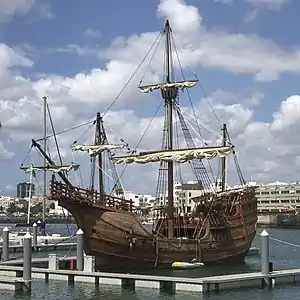 Santa Maria in profile (2018 replica). Front to back: forecastle, midships, aftercastle. Masts: fore, main, mizzen, fore preceded by a bowsprit.
Santa Maria in profile (2018 replica). Front to back: forecastle, midships, aftercastle. Masts: fore, main, mizzen, fore preceded by a bowsprit.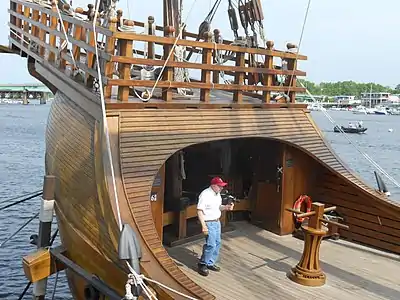 Forecastle, roofed by the foredeck. The vertical device is a capstan for weighing anchor. The senior crew lived here.
Forecastle, roofed by the foredeck. The vertical device is a capstan for weighing anchor. The senior crew lived here.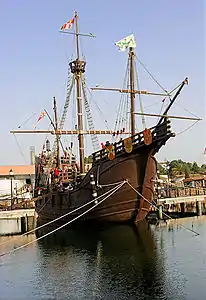 The bow or prow crowned by the forecastle. Note the keel along the middle of the hull.
The bow or prow crowned by the forecastle. Note the keel along the middle of the hull.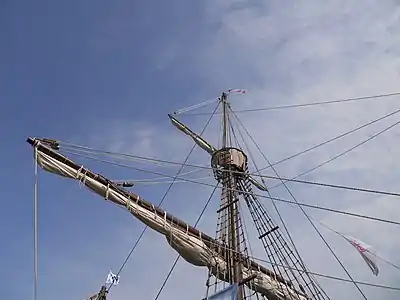 Main mast from amidships, showing spars with furled sails and the crow's nest. The marinaros, or sailors, had to be able to climb quickly up and down the rigging to access the sails for furling or unfurling, raising or lowering.
Main mast from amidships, showing spars with furled sails and the crow's nest. The marinaros, or sailors, had to be able to climb quickly up and down the rigging to access the sails for furling or unfurling, raising or lowering.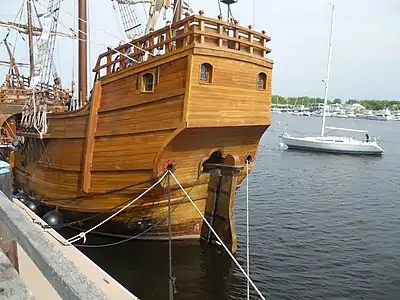 View of the stern. The deck at the top is the poop deck. Just below it is the cabin, which has windows. The door exits to the quarterdeck, which ends with a drop to amidships. The tiller fastened to the top of the rudder enters the vessel.
View of the stern. The deck at the top is the poop deck. Just below it is the cabin, which has windows. The door exits to the quarterdeck, which ends with a drop to amidships. The tiller fastened to the top of the rudder enters the vessel.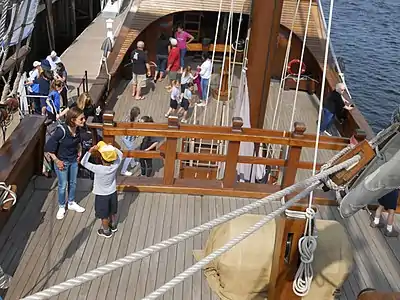 The quarterdeck seen from the poop deck. Beyond it is the midships area, and beyond that the forecastle. The men were thus obviously under observation from the quarterdeck at all times. The officers, however, had their own problems of planning the course and the configuration of the sails to achieve it.
The quarterdeck seen from the poop deck. Beyond it is the midships area, and beyond that the forecastle. The men were thus obviously under observation from the quarterdeck at all times. The officers, however, had their own problems of planning the course and the configuration of the sails to achieve it.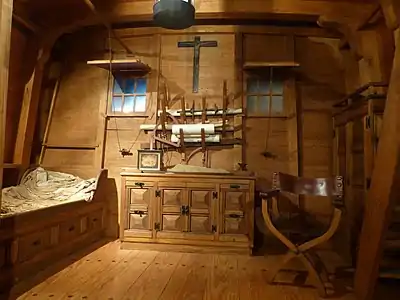 View of cabin, home of Columbus on his first voyage. No one else had these luxurious accommodations. There were no other cabins. Note the charts in the rack.
View of cabin, home of Columbus on his first voyage. No one else had these luxurious accommodations. There were no other cabins. Note the charts in the rack.
The studies of Alice Bache Gould
Alice Bache Gould is considered the major scholar of the ship's company of the first Santa Maria during the first voyage of Columbus. She spent the better part of her working career in Spain researching the records on Columbus and his times, only coming home for a few years to avoid the Spanish Civil War. Gould died of natural causes before she was able to publish a book, but her articles and notes survive. A book was assembled for her posthumously and published in 1984 by the Real Academia de la Historia in Madrid. It is entitled Nueva lista documentada de los tripulantes de Colón en 1492
Building the list
She began with the existing lists of three major contributors, whom she termed "Fernández Duro," "Tenorio" and "Vignau." In the comparative list they each received their own column headed by their own abbreviation: FD, T, and V respectively. The list is a column of names with the additional columns marking which author was "in" or "out" for that name. She explains that the only way she could make a comparative list was to arrange them in alphabetic order by first name, as the first names in the sources varied least of all. Each item in the list has a phrase distinguishing the person, almost always their position. She explains that the full entry is given in a later installment (which it is). She had her own column, headed G for "Gould." There are actually four tables, one for 87 secure names, one for imaginary names, one for wrong names, and one for remaining names, considered uncertain from Gould's point of view. The G names were only in the secure category.[80]
Comparing and further investigating the three lists (her own being the fourth) and the documents on which they were based, she undertook to distinguish fact from fancy and to fill in sociological information by analysis. She called the 87 "the crew list" (los tripulantes de Colón en 1492) without making the fine distinctions of the long tradition of maritime language. For example, if "tripulantes" were "de Colón" then Colón was not one of them. The final list aimed at everyone on board the three ships regardless of rank or position; thus, the three captains and the admiral were among them. There were no passengers, marines, expeditionaries, or settlers, as there were on the second voyage.
The records from which the total list of persons that went on the first voyage of Columbus was derived are not sufficiently complete and accurate to provide unquestonable certainty. Due to the length of time, losses by neglect and catastrophe, as well as changes in the language, and copyist errors, have left a patchwork of often contradictory source material. Any list must represent the best solutions to the many problems but there are often many possibilities. Gould's list of 87 persons authorized to be on the three ships of the fleet, has become a standard by default, but she would have been the last person to claim any sort of permanence for it. She regarded the list as being "safe" (seguros),[81] but asserted that in 50 years it would undoubtedly be quite different,[82] due, presumably, to the new discovery of old documents. After the end of the 50 years since her death, the list is still considered the best.
The figure of 87 matches the figure of 90 overall given by Las Casas. The filial biography also gives 90. Gould reluctantly adopts the 90 instead of the 120 stated by Oviedo, reluctant because she thought 90 was "insufficient." Still, 87 is not 90. Allowing for the possibility of missing records, she estimates the fleet to have included 87 through 134 persons,[83] which invalidates some modern claims that the list has been "completely known" or has "long been known." Alice never thought it was, and the 50 years of changes she anticipated never transpired, for whatever reasons. If it was not completely and accurately known then, it is not now.
Gould estimates the complement for each ship as follows. The number of men left at Fort Christmas must be about equal to the complement of the Santa Maria. If more were left, the other two crews would be short necessary sailors, and if less, the other ships would have more than they planned for. As 39 men were left, Gould rounds off to about 40 men. The ones left would not necessarily have been crewmen of the Santa Maria. They were very likely volunteers, with the crew of the Santa Maria filling in for them.
The Nina went on Columbus' attempt to explore the coast of Cuba on the second voyage. Columbus had each man of his fleet of three interviewed as to whether he thought Cuba was mainland Asia, and make an affidavit. The number of affidavits on the Nina were recorded. The company of 16 for the Nina must represent the number of men required to sail the ship. Gould therefore rounds off to 20, leaving 30 for the Pinta.
The sources
The gaps in the records are an accumulation of losses and errors over a period of some centuries. Ferdinand and Isabella left little to chance. They created an administration that exercised total control over the growth of the Spanish Empire. It kept detailed records. The first step was to appoint a royal officer, the Bishop of Badajoz, to manage the fleet of exploration. Isabella appointed her own chaplain (Juan Rodríguez de Fonseca). He handled matters such as the payroll, pensions, supplies and outfitting, etc.
By 1503, near the end of their joint reign – Isabella was to die the next year, while Ferdinand lost the regency and the lordship of the Indies – the royals created the Casa de Contratación de las Indios in Seville, a royal agency to manage all New World exploration. Fonseca went on into the Casa, implementing their intention long after they were dead. It had sweeping powers to do everything required: hire and train cosmographers (a combination of map-maker and navigator), manufacture charts, procure ships, assign explorations, designate colonists, manage colonies from afar, impose taxes upon them, and so on. It kept records of every aspect. Kept secret in the organization was the map template for produced maps. Evidently the experiences of Juan de la Cosa caused them to change the open map policy.
As the Empire continued to grow, in 1524 the monarch placed another level of management over the Casa: the Council of the Indies. It assumed most of the powers of the Casa. In addition it managed the new Spanish possessions in South and Central America as well as Mexico. The long-lived Fonseca went on into the Council, providing continuity. The Council also kept all the records of empire going back to the late 15th century, when it all began. They had been dispersed to different cities until in 1785 the General Archive of the Indies was created. The records were all to be moved to a new home in the building of the Casa Lonja de Mercadores in Seville, but a space problem soon became evident. it was decided to leave all records created in 1760 and after where they were; thus, a number of other important archives remain, one of which is the Archivo General de Simancas north of Madrid, the former royal archive. Gould spent the latter portion of her life working there, and died there in the entrance. The two archives have been designated UNESCO World Heritage Sites.
The first author in Gould's history of the list is Martín Fernández de Navarrete (1765 – 1844), a nobleman who had gone to sea as a midshipman at age 15 and, showing remarkable talent, had risen swiftly through the ranks of the officers. Invalided by poor health he became inactive but as a reward for his nobility, enthusiasm and interest, the monarch gave him a commission to research the archives for material relating to a maritime history of Spain. There he discovered the condensations of the logs for Columbus' first and third voyages.
His researches were interrupted by Spain's war with Bonaparte, which it lost. Navarrete had rejoined, rose to command a frigate, fought in some major battles, and was solicited by Napoleon to become the minister of the navy of occupied Spain. Refusing, he retired to Andalusia to work on a constitution for the new Spain. When the conflict with Bonaparte was all over, and the revolutionary dictator was in exile, Navarrete was made director of the Real Academia de la Historia, from 1824 to his death in 1844, in which capacity he was an intensely prolific author, producing hundreds of works. His first task was the resumption of his history of the exploratory voyages of Spain, the first volume of the first edition coming out in 1825.Volume II also came out in 1825. One of its chapters contains a list of 40 men described as "Lista de las personas que Colon dejó en la Isla Española y halló muertas por los Indios cuando volvió a poblar;" that is, it is a list put forward as being the men who died at Fort Christmas.[84]
In 1884 another professional naval officer turned historian, Cesáreo Fernández Duro, published a work, Colon y Pinzon, that presented list of 88 men who had gone with Columbus on the first voyage.
Gould's "Crew list" for the Santa Maria
The crew of Santa María is well-known,.[85]
The crew was not composed of criminals as is widely believed.[86] Many were experienced seamen from the port of Palos in Andalusia and its surrounding countryside, as well as from the region of Galicia in northwest Spain. It is true, however, that the Spanish sovereigns offered an amnesty to convicts who signed up for the voyage; still, only four men took up the offer: one who had killed a man in a fight, and three friends of his who had then helped him escape from jail.[86]
- Cristóbal Colón, Colom or Colombo (Christopher Columbus), captain-general[85]
- Juan de la Cosa, owner and master
- Pedro Alonso Niño, pilot
- Diego de Arana, master-at-arms
- Pedro de Gutierrez, royal steward
- Rodrigo de Escobedo, secretary of the fleet
- Rodrigo Sanchez, comptroller
- Luis de Torres, interpreter
- Bartolome Garcia, boatswain
- Chachu, boatswain
- Cristobal Caro, goldsmith
- Juan Sanchez, physician
- Antonio de Cuéllar, carpenter
- Diego Perez, painter
- Lope, joiner
- Rodrigo de Triana
- Maestre Juan
- Rodrigo de Jerez
- Alonso Chocero
- Alonso Clavijo
- Andres de Yruenes
- Bartolome Biues
- Bartolome de Torres
- James Wardropper (Lord of the Wardrobes)
- Diego Bermudez
- Domingo de Lequeitio
- Gonzalo Franco
- Jacomel Rico
- Juan (Horacio Crassocius from La Rabida Friary)
- Juan de Jerez
- Juan de la Placa
- Juan Martines de Acoque
- Juan de Medina
- Juan de Moguer
- Juan Ruiz de la Pena
- Marin de Urtubia
- Pedro Yzquierdo
- Pedro de Lepe
- Pedro de Salcedo, servant of Columbus and ship's boy
- Rodrigo de Gallego
- Pedro de Terreros, cabin boy
- Diego García
Replicas
Little is definitively known about the actual dimensions of Santa María, since no explicit documentation has survived from that era. Since the 19th century, various notable replicas have been publicly commissioned or privately constructed. Of them Morison says:
So-called models, replicas or reproductions of Santa Maria and her consorts are not models, replicas or reproductions, since no plans, drawings or dimensions of them exist; they merely represent what some naval architect, archaeologist, artist or ship modeler thinks these vessels ought to have looked like.[87]
These opinions are not entirely uneducated. A number of shipwrecks of naos have been investigated, from which verisimilar general measurements could be made, and there are some statements from the literature from which dimensions can be deduced. Whether Morison, a former admiral in the United States Navy, is bringing realism to the topic, or is being perhaps slightly more skeptical than is warranted, is a matter of opinion.
There is one sense in which none of the "replicas" replicate an ancient ship: the concessions to the conveniences of the modern world, especially on the ships meant actually to sail. These are well-hidden: it might be an engine, or modern rudder machinery in a closed compartment, or communications equipment. No modern sailors are expected to undergo the hardships of a 15th-century voyage. They have bunks where Columbus' sailors slept on the deck, and modern stoves instead of cooking fires on the deck. In case of emergencies, help is a radio call away. The Renaissance seamen risked life and limb, and some died on every voyage. They feared going to sea, and if they did go, feared to get out of sight of land.
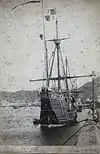
Quadricentennial
Interest in reconstructing Santa María started in Spain at around 1890 for the 400th anniversary of Columbus's voyage. An 1892 reconstruction by the Spanish government depicted the ship as a nau.[88]
West Edmonton Mall

A replica was built during Expo 86 and anchored in "Deep Sea Adventure Lake" at West Edmonton Mall. Built at False Creek in Vancouver, British Columbia, the ship was hand-carved and hand-painted, and then transported by flatbed trucks across the Rocky Mountains to Edmonton, Alberta.[89]
Quincentennial
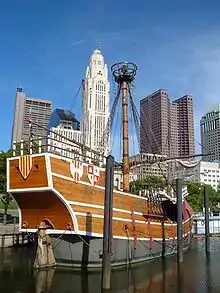
A replica, depicted as a Carrack, was commissioned by the city of Columbus, Ohio as a museum ship, the Santa Maria Ship and Museum.[90] It was built by the Scarano Brothers Boat Building Company in Albany, New York, who later cut the ship in half and transported it by truck to the Scioto River. The replica cost about 1.2 million dollars. The ship was constructed out of white cedar as opposed to an oak wood used on the original to give the ship a long life in the Scioto River and to reduce cost. The main mast was carved out of a single douglas fir tree and was equipped with a top sail (since removed). The ship was built using power tools, with a hull length of 29.6 m (97 ft), keel length 16.1 m (53 ft), beam 7.9 m (26 ft), depth 3.2 m (10 ft) and load 223.8 metric tons of displacement. The foremast is 9.7 m (32 ft) high, the mainmast is 15.9 m (52 ft) and mizzen mast is 10.4 m (34 ft). The replica was declared by Jose Maria Martinez-Hidalgo, a Spanish marine historian, to be the most authentic replica of the Santa María in the world during the ship's coronation on 12 October 1991.[91]
Dana Rinehart, the 50th mayor of Columbus, christened the ship as part of the 500th anniversary of its voyage. The ship was removed from its moorings in 2014, cut into 10 pieces, and stored in a lot south of the city, pending funding to do repairs and restorations. As of early 2016, the plans for restoration have stalled. Its parts can be seen via satellite view on Google Maps .
Madeira
A functional replica was built on the island of Madeira, between July 1997 and July 1998, in the fishing village of Câmara de Lobos. The ship is 22 m (72 ft) long and 7 m (23 ft) wide. In 1998 Santa María represented the Madeira Wine Expo 98 in Lisbon, where she was visited by over 97,000 people in 25 days. Since then thousands more have sailed and continue to sail aboard that Santa María replica which is located in Funchal.[92]
- 1998 and later replicas
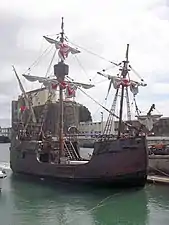 Santa Maria de Colombo, built by craftsmen from Câmara de Lobos, Madeira
Santa Maria de Colombo, built by craftsmen from Câmara de Lobos, Madeira_(2).jpg.webp) 1998 replica in Madeira
1998 replica in Madeira
 The close bow wave and the turbulent wake astern reveal the hidden presence of an engine, as there is no sail on to account for the speed.
The close bow wave and the turbulent wake astern reveal the hidden presence of an engine, as there is no sail on to account for the speed.
See also
- Columbian Exchange
- Niña
- Pinta
- Pinzón brothers
- Santa María Rupes, a ridge on planet Mercury named after this ship
- Ship replica (including a list of ship replicas)
- Voyages of Christopher Columbus
- Wharf of the Caravels
References
- This is the document called by some writers "the Diary," but it was not a personal diary. The naval protocol was for all commanding officers to keep logs of day-to-day events.
- Columbus & Markham 1893, p. 17
- Columbus & Markham 1893, pp. v–vii
- Davidson 1997, p. 233
- Columbus & Hale 1891, p. 47
- Nowell 1939, p. 1
- The main sources that cover the topic concur that de la Cosa happened to be in the port when Columbus was making his selection. For example: Canova & Vascano 1832, pp. 77–78 "...the said nao Santa María, being in the waters of the County of Niebla (probably in the port of Huelva) when the fleet for the Columbus expedítion was being organized, Columbus was struck with her, and, at once entered into treaties with her owner and captain, Juan de la Cosa, for employing her in his expedition of discovery, with the condition of being allowed to hoist his Ensign of Admiral on her mast head." Huelva is across the Rio Tinto from Palos.
- Canovas & Vascano 1892, p. 78, English Chapter III "...one of the great defects in the character of Columbus being that he could not suffer any one to shine in his presence."
- Columbus & Markham 1893, p. 59 "... the capitulation, prepared by the secretary, Juan de Coloma, was signed at Santa Fe by their Highnesses on 17 April 1492. In return for his discoveries, Columbus was created Admiral of the Ocean in all those islands and continents that he might discover. The title was granted to him for his life, and to his heirs for ever...."
- Columbus & Hale 1891, pp. 44–46 "On the 23rd of May, Columbus went to the church of San Giorgio in Palos, with ... important people, and the royal order was read with great solemnity. But it excited at first only indignation or dismay. The expedition was most unpopular. Sailors refused to enlist, and the authorities, who had already offended the crown, so that they had to furnish these vessels, as it were, as a fine, refused to do what they were bidden."
- Riega 1897, p. 20 No habia tiempo ni sobraba dinero para ir de puerto en puerto examinando buques ....
- Columbus & Markham 1893, p. 135
- Columbus & Markham 1893, p. 138 For example, "If it had not been for the treachery of the master and his boat's crew, who were all or mostly his countrymen (Cantabrians, some basques, who had been in the previous crew), in neglecting to lay out the anchor so as to haul the ship off in obedience to the Admiral's orders, she would have been saved."
- One explanation postulates a conflict in social roles: "Certainly Juan de la Cosa as a master should have been on his guard and not allow the helmsman to give the helm to a novice, as he seems to indicate in his "Diary." But Barreiro-Meiro comes out in defense of the Cantabrian, noting that there was more than one master (más de un maestre) in the nao and that it was not La Cosa that was performing at that time. Pery 2000, p. 54.
- Approximately one shipload of grain. One cahiz is 666 liters or 19 bushels dry measure (round figures). It is not clear whether "take" means for free, or whether this is a one-time payment or a franchise for regular trade. If a franchise, it could not be for free, as that value would be worth an indefinite number of ships.
- Picatoste y Rodríguez 1891, p. 64
- Pery 2000, p. 51
- Vecino or vesino is a uniquely Spanish reflex of Latin vicinus, a resident of a vicus, a specific community. It retains the "neighbor" implication of a "neighborhood" not present in English resident, citizen, or inhabitant. Vesinos were typically intensely loyal to each other and to the vicus. In time Roman vici grew to urban proportions.
- Picatoste y Rodríguez 1891, p. 65 "De todos estos documentos se deduce que Juan de la Cosa se embarcó en el segundo viaje de Colón, escogido por éste como hábil piloto y perito navegante. Recorrió, pues, la isla de Cuba y la bahía de Samaná, y en 1496 volvió á España y se retiró á Santoña, como consta por una carta de la Reina Doña Isabel, fechada en Laredo á 25 de Agosto de 1496, y dirigida al Obispo de Badajoz, en que habla de una petición de Juan de la Cosa, «vecino de Santoña»,a mandando que se pagasen sus alcances á los que fallecieron en las Indias en el servicio real."
- Davidson 1997, p. 234
- However, all Basque families had the rights and privileges of nobility, which was the price paid by the crown of Castille for their support. Garate 1993, pp. 80–82
- Picatoste y Rodríguez 1891, p. 65
- Garate 1993, p. 84
- Bass 2010, p. 4
- Siebold 2019, p. 1
- Davies 1976
- Hale covers many of the treaties, underscoring the attempted use, by these Catholic kings, of the Pope to lend authority to their proposed lines of demarcation. Columbus & Hale 1891, pp. 134–137. The discovery was entirely Catholic. Henry VIII, founder of English protestantism, had yet to sit on the throne.
- Davies 1976, p. 113
- Davies 1976, p. 118
- Chanca 2003, pp. 281–282
- Chanca 2003, p. 283
- Columbus & Keene 1934, p. 101
- Columbus & Keene 1934, pp. 103–105
- Columbus & Keene 1934, pp. 105–108
- Columbus & Keene 1934, pp. 108–109
- Columbus & Major 1870, p. 102
- Columbus & Major 1870, p. 98
- Columbus & Major 1870, p. 82
- Columbus & Major 1870, p. 21
- Columbus & Major, p. 22
- Columbus & Keene 1934, p. xv The translation notice on the 1571 edition is: Nuovamente di lingua Spagnuola tradotte nell’Italiana dal S. Alfonso Ulloa, “Newly translated from the Spanish language into Italian by Señor Alfonso Ulloa.” The Spanish manuscript, which was not otherwise published, is lost.
- Colombo 1571, p. 93
- Chanca 2003, pp. 307–308
- Chanca 2003, p. 312
- Columbus & Major 1870, pp. 78–81
- Castro 2008, p. 72
- The Greco-Roman civilization knew the Basques as the Vascones, in which Eusk- becomes Vasc-. From the Roman form came "Basque", "Biscay," and "Gascon." Unable to maintain their own country, Basque-speakers formed a sort of quasi-hidden brotherhood in the cultures in which they participated, such as the Spanish explorations of the New World.
- Totoricagüena 2005, p. 56, Chapter 3
- Riega 1897, p. iv
- Peter van der Krogt. "Pontevedra – Monumento a la Santa Maria". Vanderkrogt.net. Retrieved 30 September 2015.
- "Tesis sobre colon gallego y de Pontevedra". cristobal-colon.com. Archived from the original on 30 September 2015. Retrieved 30 September 2015.
- William D. Phillips; Carla Rahn Phillips (1992). The Worlds of Christopher Columbus. Cambridge University Press. pp. 143–145. ISBN 978-0-521-44652-5.
- "Christopher Columbus Ships". Elizabethan-era.org.uk. 16 May 2012. Retrieved 15 July 2014.
- Archived 30 April 2010 at the Wayback Machine
- Gould, Richard A. (2000). Archaeology and the Social History of Ships. Cambridge University Press. p. 206. ISBN 9780521567893.
- The actual decree was the Edict of Expulsion, dated 31 March 1492, now called the Alhambra Decree.
- Netanyahu, Benzion (2001). The Origins of the Inquisition in Fifteenth Century Spain (Second ed.). New York: New York Review of Books. pp. 1090–1091. Sometimes all conversos in a region were declared heretic and were automatically tortured and killed. The treatment of the Jews at that time was complex and far from rational, as the author analyzes. As Columbus and his friends were never under any suspicion of being marranos, and were totally trusted by the king and queen, it is unlikely that they could have proceeded with the expedition if in any way caught up in the web of conspiracy against Moors and Jews.
- Columbus & Keen 1934, p. 17 Ferdinand cites as another reason the desire to find new lands, which the great distance led him to suspect were there.There is thus no need to hypothesize some prior knowledge of them on his part. There were, however, persistent stories of land to west of the Azores, which Christopher, after investigation, discounted. Ferdinand knew one of them as "the land of cod" (page 27).
- Morison 1942, pp. 101–102
- Strictly speaking, there was no Italy and no Italian until Giuseppe Garibaldi unified Italy in the 19th century. In the centuries since the fall of Rome, Italy had become several states speaking different Romance languages. There was, however, a universal popular desire to re-create a single country. Tuscan, considered the purest Romance language, became the basis for a new Standard Italian. Tuscan had already been called Italian by the literate classes for a number of centuries; however, most people were not literate. Tuscan was not genrally spoken outside Tuscany. In the 15th century, the Columbus family was Genoese; that is, they resided in the Republic of Genoa and spoke the Genoese dialect of Ligurian. All arguments based on the "Italian" or "Spanish" of Columbus are anachronistic, as he did not live in the modern world or speak any of its languages.
- There is the question of why de Santángel should be so trusted when so many conversos were being arrested on suspicion of being marranos. Markham asserts that Columbus fought with the army before Granada in 1492. The royals were thus inclined to trust and reward him if they could. Columbus & Markham 1893, p. 56
- Morison 1942, pp. 102–105
- Columbus, Christopher (2007). National Humanities Center (ed.). "Columbus's letter on his first voyage to America, February 1493" (PDF). National Humanities Center.
- Columbus & Markham 1893, p. 56
- Columbus & Keen 1934, p. 71 Markham thinks the natives may have been using the noun bohio, "home," in their language, which he doubted the Spanish understood: Columbus & Markham 1893, p. 68
- Columbus & Markham, pp. 59–83
- Columbus & Markham 1893, p. 132
- Columbus & Markham 1893, p. 133
- Davies 1953, p. 858
- Maclean, Frances (January 2008). "The Lost Fort of Columbus". Smithsonian Magazine. Retrieved 24 January 2008.
- "Haïti histoire – 7 Bord de Mer de Limonade". Nilstremmel.com. Retrieved 15 July 2014.
- "Article du Florida Museum of Natural History". Flmnh.ufl.edu. Retrieved 15 July 2014.
- Before presumed discovery of Columbus’ Santa Maria off Haiti, there was an anchor, Miami Herald, 25 May 2014
- Paret, Robert (2010). "MUPANAH and the Promotion of Historical and Cultural Values". Museum International. 62 (4): 39–45. doi:10.1111/j.1468-0033.2011.01744.x. S2CID 142632278.
- David Keys (13 May 2014). "Exclusive: Found after 500 years, the wreck of Christopher Columbus's flagship the Santa Maria". The Independent. Retrieved 13 May 2014.
- Maranzani, Barbara (13 May 2014). "Has Wreckage of Christopher Columbus' Flagship Been Found?". History.com. Archived from the original on 14 May 2014. Retrieved 14 May 2014.
- "Shipwreck is not Santa Maria, UNESCO experts say". Paris: UNESCO. 6 October 2014. Retrieved 6 October 2014.
- "Haiti shipwreck is not Columbus's Santa Maria, says Unesco". The Guardian. London. AFP, Paris. 6 October 2014. Retrieved 6 October 2014.
- Laura Smith-Spark (7 October 2014). "Haiti wreck isn't Columbus' ship Santa Maria, U.N. says - CNN.com". CNN.com. CNN. Retrieved 29 September 2015.
- 2006B, pp. 156–159
- Gould & 2006B, p. 153
- Gould & 2006B, p. 145 "La lista que ahora ofrezco no puede ser completa, ni mucho menos. De aquí a cincuenta años seguramente se sabrá más de Colón y de sus asuntos. Lo que deseo es, que por muchas que sean las ampliaciones futuras, haya poco que borrar en lo que aquí se ofrece."
- Gould & 2006B, p. 154
- Navarrete, Martin Fernandez de (1825). Colección de los viages y descubrimientos que hicieron por mar los españoles desde fines del siglo XV, con varios documentos inéditos concernientes á la historia de la marina castellana y de los establecimientos españoles en Indias. II. Madrid: Imprenta real. pp. 18–20.
- The Columbus Navigation Homepage. "Columbus's Crew". Archived July 2011. Accessed 2 June 2012.
- Hale, Edward Everett. The Life of Christopher Columbus, Ch. IX. 1891.
- Morison 1942, p. 113
- "QUEER CRAFT THESE CARAVELS. – Those Who Saw Them Hobble to Anchor Marveled at Columbus's Pluck". New York Times. 26 April 1893. Retrieved 18 November 2015.
- West Edmonton Mall. "WEM Santa Maria page". Wem.ca. Retrieved 15 July 2014.
- Pastor, Xavier (1992). The Ships of Christopher Columbus. London: Naval Institute Press. ISBN 978-1-84486-014-2.
- Albrecht, Eric. "Setting Sail for Parts Unknown: Santa Maria!". photographcolumbus.wordpress.com. Retrieved 11 August 2015.
- "Santa María de Columbo". Santamariadecolombo.com. Retrieved 15 July 2014.
Bibliography
- Azcona Pastor, J.M.; Douglass, W.A. (2004). Possible paradises: Basque emigration to Latin America. Reno, Nevada: University of Nevada Press.
- Bass, Stephen T. (2010). "Basques in the Americas from 1492 to 1892: a Chronology" (PDF). Cite journal requires
|journal=(help) - Canovas, Antonio; Vascano, Antonio (1892). Ensayo biográfico del célebre navegante y consumado cosmógrafo Juan de la Cosa y descripción e historia de su famosa Carta geográfica (in Spanish, French, and English). Madrid: Tipo-litografía de V . Faure.
- Castro, Filipe (2008). "In Search of Unique Iberian Ship Design Concepts". Historical Archaeology. 42 (2): 63–67. doi:10.1007/BF03377074. JSTOR 25617496. S2CID 35957211.
- Chanca, Diego Alvarez (2003). Bourne, Edward Gaylord (ed.). Letter of Dr. Chanca on the Second Voyage of Columbus (PDF). American Journeys Collection Document No. AJ-065. Translated by Major, R.H. Wisconsin Historical Society.
- Colombo, Fernando (1571). Historie del S.D. Fernando Colombo nelle quali s'ha particolare, & vera relatione della vita, & de' fatti dell'ammiraglio D. Christoforo Colombo, suo padre; et dello scoprimento, ch'egli fece dell'Indie Occidentali, dette Mondo Nuovo, hora possedute dal Sereniss. Re Catolico (in Italian). Translated by Ulloa, Alfonso de. Venetia: Franceschi Sanese.
- Columbus, Christopher; Hale, Edward Everett (1891). "The life of Christopher Columbus, from his own letters and journals and other documents of his time". Internet Archive. Chicago: G.L. Howe & Co. Retrieved 27 June 2019.
- Columbus, Christopher (1870). Major, Richard Henry (ed.). Select Letters of Christopher Columbus, with Other Original Documents, Relating to His Four Voyages to the New World. Translated by Major, Richard Henry (Second ed.). London: Hakluyt Society.
- Columbus, Christopher; Markham, Clements R. (1893). "The Journal of Christopher Columbus (During His First Voyage, 1492–93) and Documents Relating to the Voyages of John Cabot and Gaspar Corte Real". Internet Archive. London: Hakluyt Society. Retrieved 27 June 2019.
- Columbus, Ferdinand; Keen, Benjamin (1934). "The Life of the Admiral Christopher Columbus By His Son". Internet Archive. New Brunswick, New Jersey: Rutgers University Press. Retrieved 23 June 2019.
- Davidson, Miles H. (1997). Columbus Then and Now: A Life Reexamined. Norman, Oklahoma: University of Oklahoma Press.
- Davies, Arthur (1953). "The Loss of the Santa Maria Christmas day, 1492". The American Historical Review. 58 (4): 854–865. doi:10.1086/ahr/58.4.854.
- Davies, Arthur (1976). "The Date of Juan de la Cosa's World Map and Its Implications for American Discovery". The Geographical Journal. 142 (1): 111–116. doi:10.2307/1796030. JSTOR 1796030.
- Garate, Donald T. (1993). "Basque Names, Nobility, and Ethnicity on the Spanish Frontier". Colonial Latin American Historical Review. 2 (1).
- Gould, Alice Bache (2006A). "Nueva lista documentada de los tripulantes de Colón en 1492 [1]" (in Spanish). Biblioteca Virtual Miguel de Cervantes. From Boletín de la Real Academia de la Historia, tomo 85 (1924), pp. 34-49.
- Gould, Alice Bache (2006B). "Nueva lista documentada de los tripulantes de Colón en 1492 [2]" (in Spanish). Biblioteca Virtual Miguel de Cervantes. From Boletín de la Real Academia de la Historia, tomo 85 (1924), pp. 145-159.
- Morison, Samuel Eliot (1942). Admiral of the Ocean Sea. Boston: Little, Brown and Company.
- Nowell, Charles E. (1939). "The Columbus Question: A Survey of Recent Literature and Present Opinion". The American Historical Review. 44 (4): 802–822. doi:10.2307/1844405. JSTOR 1844405.
- Pery, José Cervera (2000). "Juan de la Cosa: el marino el hombre" (PDF). In Hierro, José Ignacio González-Aixer (ed.). Juan De La Cosa: Ciclo De Conferencias Octubre 1999: Cuadernos Monográficos Del Instituto De Historia Cultura Naval N.° 35. XX Jornadas De Historia Marítima (in Spanish). Madrid: Instituto De Historia Cultura Naval.
- Picatoste y Rodríguez, Felipe (1891). "Cosa (Juan de la)". Apuntes para una Biblioteca científica Española del siglo XVI : Estudios biográficos y bibliograficos de ciencias exactas físicas y naturales y sus inmediatas aplicaciones en dicho siglo (in Spanish). Madrid: Manuel Tallo.
- Riega, Celso García de la (1897). La gallega: Nave capitana de Colón en el primer viaje de descubrimientos (in Spanish). Pontevedra: J.A. Antunez.
- Siebold, James (2019). "Juan de la Cosa Portolan World Chart" (PDF). myoldmaps.com/Renaissance Maps: 1490 – 1800. Retrieved 13 July 2019.
- Totoricagüena, Gloria (2005). Basque Diaspora Migration and Transnational Identity (PDF). Basque Textbooks Series. Reno: Center for Basque Studies, University of Nevada.
External links
| Wikimedia Commons has media related to Santa María. |
- "Santa María (as in Niña, Pinta, & Santa María)". Mike & David's Adventures. 13 August 2018.
